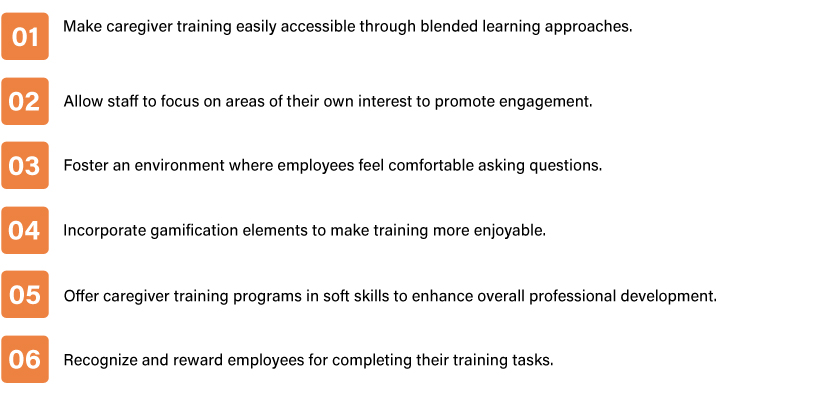
While it’s ideal to welcome new hires with personalized touches and extensive training programs, the main challenge for training providers today is ensuring employees complete their training before they start providing care. To address this, it’s crucial to prioritize compliance training tailored to your organization’s needs.
Based on the 2022 State of Training Report, many agencies are streamlining their training programs by focusing on these key areas-
So, how can you implement these while ensuring your caregivers provide the utmost care?
Keep on reading to find out.
Assessing your organization’s compliance training is crucial, no matter which home care field you’re in. Whether it’s home care, skilled home health, facility-based care, or hospice, take the time to check if your professional caregiver training meets state and federal rules, as well as any extra requirements from your organization or accrediting bodies.
Ensure your training covers all the necessary topics and stays updated with your organization’s and regulatory guidelines. Moreover, you need to also make sure your compliance training plan meets your organization’s standards. Choose training programs focusing on meeting these standards and teaching employees about safety, managing risks, and respecting individual rights. Effective compliance training keeps you legal and builds a culture of safety and responsibility in your workplace.
After ensuring your organization meets compliance standards, it’s vital to structure your training program for optimal employee and client/patient success.
Surprisingly, only 38% of agencies utilize Key Performance Indicators (KPIs) to evaluate training effectiveness, potentially leading to dissatisfaction among employees and clients/patients.
To gauge the efficacy of your training, consider auditing it against these 7 key metrics-
1. Achieving a 100% training completion rate.
2. Ensuring your training platform is mobile-friendly for convenient on-the-go access.
3. Implementing a Learning Management System (LMS) for streamlined training management.
4. Incorporating both orientation and ongoing training into your program.
5. Offering online and in-person training options to accommodate different learning styles.
6. Embedding training into your company’s core values and performance evaluations.
7. Provide at least 5 hours of training during orientation and 8 hours of ongoing training if additional training isn’t already mandated for the position or location.
By auditing your caregiver training program against these metrics, you can enhance its effectiveness and address potential areas for improvement, ultimately fostering a culture of continuous learning and excellence within your organization.
Keeping your employees engaged throughout the process ensures a high training completion rate. More than simply assigning training tasks is required; your staff must be motivated to complete them, and that starts with your approach.
Investing in your employees’ personal development improves staff performance and enhances job satisfaction. However, you’re not alone if you’re facing challenges in maintaining high completion numbers. According to the 2022 State of Training Report, 35% of respondents identified engaging employees as their top training weakness.
Here are some strategies to keep your employees motivated and compliant with their training-

Remember, compliance isn’t a one-time event; it’s an ongoing effort. Compliance training forms a significant portion of many organizations’ training programs. Cultivate a company culture that values learning and celebrates achievements to meet compliance standards consistently.
If you’re not already part of the 62% of providers using a Learning Management System (LMS), you might be adding unnecessary workload to your plate when it comes to compliance training.
Here’s how adopting an LMS like Learn2Care can simplify your compliance efforts:
You can feel confident that you are equipping your caregivers with content that adheres to the US CMS HHA Conditions of Participation for home health aide services.
Set up learning paths automatically assigning necessary courses to each new hire, ensuring everyone receives the essential caregiver training.
Monitor which employees have completed their training to identify any compliance risks within your organization.
Keep all training histories conveniently stored in one place, making audits smoother and more manageable.
Utilize KPIs to measure the effectiveness of your online caregiver training efforts. Nearly 100% of organizations that tracked their agency’s KPIs used an LMS.
Be rest assured because the content provided by Learn2Care aligns with the US CMS HHA Conditions of Participation for home health aide services.
The adaptability of online training platforms allows caregivers to learn at their own pace. This flexibility enhances engagement and improves knowledge retention, creating an optimal learning environment for caregivers.

Compliance training is more than a one-size-fits-all approach. While there are methods to simplify planning and assessment, it’s crucial to recognize the broader significance of compliance training.
By implementing the strategies discussed, you can customize caregiver training programs to fit your company’s culture and values. This prioritizes employee well-being and safety and strengthens overall security measures. Compliance goes beyond checkboxes; it drives meaningful, positive organizational change.
Compliance & Best Practices: Staying Ahead of the Curve in Caregiving Regulations
Contact us to inquire about our state-wise training courses and take the first step towards upskilling your team with a 14-day free trial!